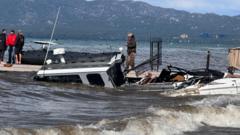Did Trump Have the Power to Strike Iran?

Understanding the Constitutional Debate Surrounding Military Strikes: A Deep Dive
In light of recent military actions ordered by President Donald Trump against Iranian nuclear facilities, a contentious debate has emerged regarding the constitutional authority of the president to engage in such military operations without prior consultation with Congress. This article seeks to unravel the complexities of this constitutional dilemma, analyzing relevant articles of the U.S. Constitution, historical precedents, and the implications of the War Powers Resolution. As we explore these elements, we will also highlight various perspectives from legal experts and lawmakers to provide a comprehensive overview of the situation.
Summary of Events: Recent Military Strikes on Iran
Following President Trump’s decision to initiate airstrikes on several Iranian nuclear facilities, reactions have been polarized. Prominent figures from both the Democratic Party and within the Republican Party have voiced concerns over the legality of these actions. Republican Congressman Thomas Massie characterized the strikes as "not Constitutional," while Congressman Warren Davidson echoed similar sentiments, emphasizing the difficulty in rationalizing the strikes under constitutional authority. In contrast, House Speaker Mike Johnson defended the president's decision, arguing that he acted in the face of imminent danger, a justification rooted in a longstanding tradition of military actions taken by presidents from both parties.
The Constitutional Framework: Articles I and II
To grasp the legal intricacies surrounding the president's authority to engage in military actions, it is essential to examine two critical articles of the U.S. Constitution: Article I and Article II.
Article I: Congressional Authority to Declare War
Article I of the U.S. Constitution explicitly grants Congress the power to declare war. This authority is a cornerstone of the legislative branch's ability to check the powers of the executive branch. Historically, this provision has been invoked sparingly; Congress has formally declared war only a handful of times since the Constitution's ratification in 1788.
- The last formal declaration of war occurred in 1942 against Japan, following the Pearl Harbor attack.
- Prior to that, there have been only ten declarations of war since 1812.
Article II: Presidential Powers as Commander in Chief
Article II of the Constitution outlines the powers of the president, including the role of Commander in Chief of the Armed Forces. This article provides the president with the authority to direct military operations, particularly in circumstances where rapid action is necessary. However, the constitution does not explicitly define the limits of this authority, leading to divergent interpretations by legal scholars.
Legal Interpretations: Presidential Authority vs. Congressional Oversight
Legal experts have weighed in on the validity of Trump's actions based on these constitutional provisions. While some argue that the president has the authority to act unilaterally in cases of imminent threat, others contend that such actions should require Congressional approval to maintain a system of checks and balances.
Arguments Supporting Presidential Authority
Legal scholars advocating for the president's authority point to the following interpretations:
- Imminent Threat: Presidents can act to repel an imminent attack or to protect national security interests. This has been interpreted to include actions taken to prevent nuclear proliferation, as was claimed by the Trump administration regarding Iran.
- Historical Precedent: Many past presidents, including Barack Obama and Bill Clinton, have authorized military actions without Congressional approval, citing Article II as their legal justification.
Counterarguments: The Need for Congressional Approval
Conversely, critics of Trump's strikes have highlighted several key points:
- War Powers Resolution: Passed in 1973, this legislation seeks to limit the president's ability to wage war without consulting Congress. Although it allows for emergency military action, it emphasizes the need for Congressional consultation whenever possible.
- Lack of Substantive Consultation: Reports indicate that President Trump did not engage in thorough discussions with Congress before the strikes, potentially violating the spirit, if not the letter, of the War Powers Resolution.
Historical Context: Precedents for Military Action
The historical context of presidential military actions reveals a pattern of increasing executive power in matters of military engagement. Notable examples include:
- President Obama’s airstrikes in Libya, which were conducted without Congressional approval under the claim of protecting civilians.
- President Trump’s own authorization of the drone strike that killed Iranian General Qasem Soleimani in 2020, which was also executed without prior Congressional consent.
- Bill Clinton’s military actions in the Balkans during the 1990s, which similarly bypassed Congressional approval.
Current Implications and Future Considerations
The ongoing debate surrounding the president's authority to engage in military actions without Congressional approval raises critical questions about the balance of power between the legislative and executive branches. As military actions become increasingly common without formal declarations of war, it is essential to consider the implications for democratic governance and accountability.
Potential Reforms and Legislative Responses
In response to the evolving landscape of military engagement, some lawmakers and experts advocate for reforms to clarify the scope of presidential authority. Suggestions include:
- Strengthening the War Powers Resolution: Enhancing the requirements for presidential consultation with Congress before military action could provide a clearer framework for accountability.
- Defining Imminent Threats: Establishing clearer definitions of what constitutes an imminent threat may help delineate the boundaries of presidential authority.
- Promoting Congressional Engagement: Encouraging a more active role for Congress in foreign policy decisions could help restore the balance of power and foster greater bipartisan collaboration.
Conclusion: Navigating the Constitutional Landscape
The constitutional debate surrounding the president's authority to order military strikes without Congressional approval is both complex and consequential. As evidenced by recent events, the interpretation of Article I and Article II continues to shape the landscape of U.S. military operations. While historical precedents provide some justification for unilateral actions, the need for checks and balances remains paramount to uphold democratic principles.
As we reflect on the implications of these military strikes and the ongoing debate, one question looms large: How can we ensure that the balance of power between Congress and the presidency is maintained in an increasingly complex global landscape? The answer may lie in a reevaluation of existing laws and a commitment to fostering collaboration between the branches of government.
Frequently Asked Questions
What is the War Powers Resolution?
The War Powers Resolution, enacted in 1973, is a federal law aimed at checking the president's power to engage U.S. forces into armed conflict without Congressional consent. It requires the president to consult with Congress before introducing U.S. Armed Forces into hostilities, except in cases of national emergency.
Can the president act without Congressional approval?
Yes, the president can act without Congressional approval in certain circumstances, particularly when there is an imminent threat or national interest at stake. However, this authority is often debated and subject to varying interpretations.
How often has Congress declared war?
Since the Constitution's ratification, Congress has formally declared war only eleven times, with the last declaration occurring in 1942 against Japan during World War II.
As the landscape of military engagement continues to evolve, the importance of understanding these constitutional provisions cannot be overstated. The implications for U.S. foreign policy and national security are significant, and ongoing discussions about the appropriate balance of power remain crucial. What are your thoughts on the balance of power in military engagement? #ConstitutionalDebate #MilitaryAuthority #ChecksAndBalances
Published: 2025-06-23 22:58:03 | Category: technology



